DeepSleep
DeepSleep support for up to 10 years (i.e., 86,400 seconds = 1 day) (e.g., if used with KNX). During DeepSleep, the device is effectively off and, as such, it is not possible to modify DeepSleepTime without exiting DeepSleep.
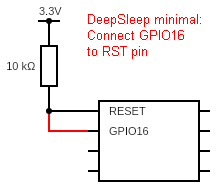
In order for the device to wake itself to perform its function during the DeepSleep cycle, the RST pin must be connected to the D0/GPIO16 pin. This is the only pin which can perform this function as the wake-up signal is sent from the RTC through D0/GPIO16 to RST. When connected to RST for DeepSleep purpose, GPIO16 may not be used for other functions. As such, it is recommended to leave it configured as None (0). On the diagram, black denotes existing parts and connections on a standard ESP board (mini-D1, NodeMCU, ...). Red denotes what is added to the DeepSleep feature.

DeepSleep modes (regular, time based)~
There are TWO general methods to work with deepsleep. Method ONE wakes up the device on a regular interval, wait for TELEPERIOD and immediate go to deepsleep again. This is mostly to make regular measurements and send them to a MQTT broker. Method TWO is more complex and use TIMER events to wakeup the device. The way and when the device go to deepsleep again depends on the configuration. See explanation below.
Repeating regular deepsleep based on interval~
(DeepSleepTime) DeepSleepTime sets the time the device remains in DeepSleep before it returns to full operating mode. Once the command is issued, the DeepSleep cycle commences.
Example
With DeepSleepTime 3600, the device will wake up exactly every hour (e.g., 8:00am, 9:00am, ...). If you define DeepSleepTime 86400 (i.e., 60*60*24), it will wake-up exactly at 0:00 local time. There is no option to shift the wakeup time; except changing the timezone. If you define DeepSleepTime 600, it will wake-up every 10 minutes (e.g., 8:00, 8:10, 8:20, ...).
Note
The next wake time will always be an even number of DeepSleepTime cycles since the epoch (Midnight 1970-01-01). This may matter if the sleep time isn't an even number of minutes/hours (ex: 3660), such as when trying to wake at a specific time of day.
DeepSleep wakeup based on TIMER events~
With Version 13.2 there is a new functionality to use TIMERS for the wakeup process on deepsleep. In this case the deepsleeptime will be dynamically calculated through the TIMERS. To enable TIMERS on deepsleep there must be a rule1 Wakeup
| rule1 | state | Behavior |
|---|---|---|
Wakeup | ON/1 | Device will do a TELEPERIOD and go to deepsleep asap, similar to deepsleep with interval |
Wakeup | OFF/0 | Device will stay ON until send to deepsleep with Restart 9 (deepsleep) |
Wakeup | ONCE/5 | Device will do a TELEPERIOD and go to deepsleep asap, with the next wakeup the device will stay ON |
Now every TIMER that has RULE as an action will wakeup the device at the proposed time. You can define multiple timers and multiple wakeups also defined on sunset or sunrise. The process will always select the NEXT wakeup it finds. As soon as all conditions meet a 60 second timer countdown starts to send the device to deepsleep. To prevent this it is recommended to disbale ALL timers on the UI during definition. If you tag the rule1 with ONCE the device will stay awake after the deepsleep. To send the device to deepsleep e.g. at sunset another rule can be used to do this:
Rule2
on time#minute==%sunset% do rule1 5 endon
Rule2 ON
Be aware that rule1 Wakeup will DISABLE the capability to use deepsleeptime. You have to clean rule1 if you want to use the regular wakeups through deepsleeptime window.
Also be aware that restart 9 does not trigger the deepsleep timing. It just send the device into deepsleep and you have to wake up the device externally.
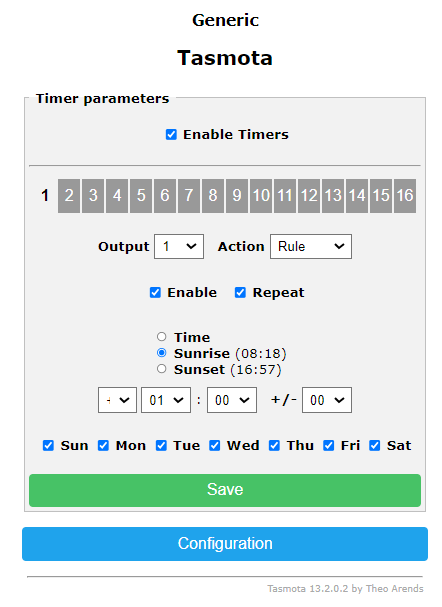
Current timer will wakeup the device every day 1h after sunrise. The Time will be dynamically calculated.
Methods to (temporarily) disable DeepSleep mode~
Using a switch~
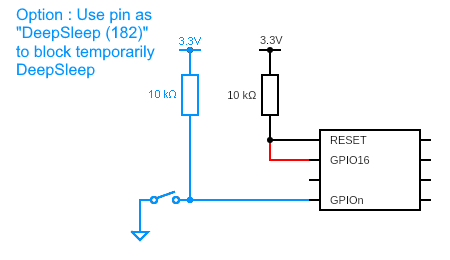
Select another GPIO (let's call it "GPIOn") and connect it GND. This can be performed through a switch per the schematic below. Flipping the switch to "ON" will prevent Tasmota to enter DeepSleep again after next wake-up until the switch is flipped back OFF. On the diagram, blue denotes additional parts and connections to be able to disable DeepSleep. GPIOn should be defined as DeepSleep (182) in the configuration as shown below:

The following GPIOs CANNOT be used for the purpose of temporarily disabling DeepSleep as described above:
- GPIO16 (because it is connected to RST),
- GPIO15 (because of an existing on-board pull-down resistor),
- GPIO0 (because pulling it down at wake up will enter serial bootload mode).
All others GPIO should be acceptable.
An interesting use-case is to disable DeepSleep when external power (USB, PSU, solar panel...) is applied to the device using a transistor.
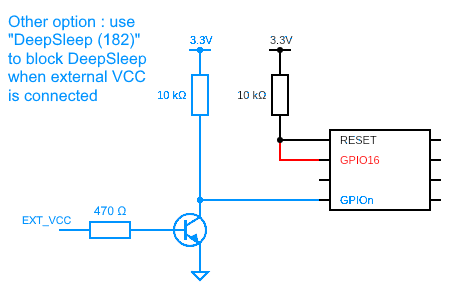
If the device is not (easily) accessible, methods can be used to disable the DeepSleep loop without physical access.
Using MQTT~
Send a retained DeepSleepTime 0 command to your device. As the message is retained in the MQTT broker, the device will receive it as soon as it connects to the MQTT broker.
Example: Sending from another Tasmota
In another Tasmota console you can type the following command:
Publish2 cmnd/%topic%/DeepSleepTime 0
To clear the retained message, once your device is out of DeepSleep, use:
Publish2 cmnd/%topic%/DeepSleepTime
Example: Sending using mosquitto utilities
Command to send a retained message:
mosquitto_pub -t "cmnd/myDeviceTopic/DeepsleepTime" -r -m "0"
Remove retained message
mosquitto_pub -t "cmnd/myDeviceTopic/DeepsleepTime" -r -n
You can also send retained message or clear them with other MQTT tools: MQTT Explorer, ....
Once you have made your configuration change, you will need to re-enable DeepSleep mode using DeepSleepTime command.
Using smart home automation~
Configure a settable flag in your home automation hub (e.g., Node-Red, openHAB, Home Assistant). The flag should subscribe to the tele/%topic%/LWT topic for the payload Online. Alternatively, if testing the payload value is not easy, subscribe to the topic tele/%topic%/STATE which is the 2nd topic on which the device publish right after waking-up.
The moment a message is received on this topic, the automation can publish a message to topic cmnd/%topic%/DeepSleepTime with payload 0. This will cause the device to disable DeepSleep and allow maintenance such as firmware updates to be performed without having an unexpected DeepSleep event. Send the DeepSleepTime 0 command only once.
Once device maintenance is completed, place it back into DeepSleep mode using original configuration.
Rules~
Example
An example of a ruleset which deepsleeps a device with a RTC module attached during a certain portion of the day (i.e. at night). Mem1 is set to wakeup time in the morning (i.e. 540) and Mem2 to sleep time (i.e. 1080). For network attached devices with no RTC module, time#initialized trigger is better than system#init. Might be smart to have a DeepSleep gpio assigned if you need to access the device outside of normal awake hours.
rule1
on system#init do backlog event timecheck=%time%; ruletimer1 1 endon
on time#minute do event timecheck=%time%; ruletimer1 1 endon
on event#timecheck<%mem1% do Var1 3600 endon
on event#timecheck>%mem1% do Var1 0 endon
on event#timecheck>%mem2% do Var1 3600 endon
on rules#timer=1 do deepsleeptime %var1% endon
The following triggers can be used to execute commands upon wake-up or right before entering DeepSleep: - Power1#Boot : is the earliest trigger. But valid only if you have a Relay output defined. - Switch1#Boot : is the next trigger, also occur very early in the boot process. But valid only if you have Switch input defined. - System#Boot : is occurring later in the Tasmota boot process but is always available. - System#Save : is occurring right before a restart or before entering DeepSleep.
For example the ruleset below turn on power right after Tasmota started, and turn it off just before entering DeepSleep
Rule1 ON Power1#Boot DO Power on ENDON ON System#Save DO Power off ENDON
Configure --> Configure module --> GPIO x to Output Hi instead of RELAY 1 and avoid using any rules. To ensure the GPIO goes LOW after deepsleep you need to solder a 4.7K resistor between GND and the GPIO. Sequence is then as follow (only key lines are shown):
00:00:00.085 CFG: Loaded from File, Count 122
00:00:00.095 Project tasmota demo-sensor Version 9.5.0(tasmota-sensors)
00:00:00.105 RUL: POWER1#BOOT performs "Power ON"
00:00:00.109 RSL: POWER = {"POWER":"ON"}
00:00:00.111 RSL: POWER = ON
00:00:04.454 WIF: Connecting to AP1 DEMOAP Channel 1 BSSId XX:XX:XX:XX:XX:XX in mode 11n as demo-sensor...
00:00:05.756 WIF: Connected
00:00:06.008 HTP: Web server active on dev-4119 with IP address 192.168.168.199
15:03:40.010 MQT: Attempting connection...
15:03:40.024 MQT: Connected
15:03:40.028 MQT: tele/demo-sensor/LWT = Online (retained)
15:03:40.032 MQT: cmnd/demo-sensor/POWER =
15:03:40.047 MQT: stat/demo-sensor/POWER = {"POWER":"ON"}
15:03:40.050 MQT: stat/demo-sensor/POWER = ON (retained)
15:03:44.472 MQT: tele/demo-sensor/STATE = {"Time":"2021-06-27T15:03:44+02:00","Uptime":"0T00:00:13","UptimeSec":13,"Heap":28,"SleepMode":"Dynamic","Sleep":50,"LoadAvg":19,"MqttCount":1,"POWER":"ON","Wifi":{"AP":1,"SSId":"DEMOAP","BSSId":"XX:XX:XX:XX:XX:XX","Channel":1,"Mode":"11n","RSSI":86,"Signal":-57,"LinkCount":1,"Downtime":"0T00:00:07"}}
15:03:44.500 MQT: tele/demo-sensor/SENSOR = {"Time":"2021-06-27T15:03:44+02:00","Switch1":"OFF","Switch2":"ON"} (retained)
15:03:44.515 RUL: SYSTEM#SAVE performs "Power OFF"
15:03:44.524 MQT: stat/demo-sensor/POWER = {"POWER":"OFF"}
15:03:44.527 MQT: stat/demo-sensor/POWER = OFF (retained)
15:03:44.539 MQT: stat/demo-sensor/DEEPSLEEP = {"DeepSleep":{"Time":"2021-06-27T15:04:00","Epoch":1624799040}}
15:03:47.433 APP: Sleeping
Driver writer: Executing commands before entering DeepSleep~
When writing a driver for a sensor, if the sensor supports a low power mode, it is a good practice to set the sensor in such low power mode in the FUNC_SAVE_BEFORE_RESTART handler. When Tasmota will restart at next wake-up, sensor will be automatically re-initialized.
Example from xsns_09_bmp.ino:
#ifdef USE_DEEPSLEEP
case FUNC_SAVE_BEFORE_RESTART:
BMP_EnterSleep();
break;
#endif // USE_DEEPSLEEP
In general you can also execute any command or special script BEFORE device goes into DeepSleep using handler FUNC_SAVE_BEFORE_RESTART as a predefined hook to implement your own procedure. This requires you to code your own function and self-compile custom firmware.
Overcome network issues~
If the device is not able to make a WIFI connection and get an IP during the first 15 seconds after boot it will go again without any further actions into deepsleep for another cycle. If you compile your own firmware you can change the timeout (e.g. 30 seconds) by setting #define DEEPSLEEP_NETWORK_TIMEOUT 30 in user_config.override or disable completely (device stay online until network connected) with #define DEEPSLEEP_NETWORK_TIMEOUT 0. If MQTT or NTP does not work the TELEPERIOD will execute anyhow and send the device to deepsleep afterwards. A wrong NTP will result in wrong timestamp send to MQTT. A missing MQTT connection will avoid any send.
Another method to send the device into deepsleep after start is creating a rule like the one below. In this case the timeout can be configured online and changed.
Rule1
ON Dimmer#Boot DO RuleTimer1 30 ENDON
ON Rules#Timer=1 DO DeepSleepTime 3600 ENDON
Rule1 ON
DeepSleep Algorithm General Timing~
Let's assume you have set DeepSleepTime 3600 (one hour) and TelePeriod 60 (one minute). The device will first wake at 8:00 am. The device will boot and connect Wi-Fi. Next, the correct time must be synchronized from one of the NTP servers and initial telemetry is sent.
DeepSleep is then triggered after the next TelePeriod event. In this example, it will occur after one minute. Telemetry will be collected and sent (e.g., via MQTT) and DeepSleep can happen. First, Offline is published to the LWT topic on MQTT. It then calculates the new sleeping time to wake-up at 9:00 am (3600 seconds after the last wake-up). At 9:00 am this same sequence of events happens again.
If you want to minimize the time that the device is in operation, two special values for TelePeriod exist: 10 seconds and 300 seconds. Using either of these two exact values will prevent waiting for the next telemetry. DeepSleep will be triggered within a few second of the time being synchronized rather than waiting for the TelePeriod.
ESP8266 DeepSleep Side-effects~
Not all GPIO behave the same during DeepSleep. Some GPIO go HIGH, some LOW, some FOLLOW the relay but work only on FET transistors. As soon as current flows they go LOW. I use one GPIO to trigger a BC337 transistor to switch OFF all connected devices during DeepSleep.
Findings:
| Pin | GPIO | Behavior |
|---|---|---|
| D0 | 16 | Excluded due to use as wake-up pin |
| D1 | 5 | KEEP STATE, go LOW if resistance to ground < infinite |
| D2 | 4 | KEEP STATE, go LOW if resistance to ground < infinite |
| D3 | 0 | HIGH |
| D4 | 2 | HIGH |
| D5 | 14 | HIGH, go LOW if resistance to ground < infinite |
| D6 | 12 | HIGH, go LOW if resistance to ground < infinite |
| D7 | 13 | HIGH, go LOW if resistance to ground < infinite |
| D8 | 15 | LOW |
Log Output Explanation~
(logging level 4)
When MQTT connects at 13:08:38, this sets the system to READY.
13:08:43 MQT: tele/tasmota/INFO3 = {"RestartReason":"Deep-Sleep Wake"}
13:08:44 APP: Boot Count 3
13:08:44 CFG: Saved to flash at F4, Count 96, Bytes 3824
In the context of DeepSleep, maintaining a device boot count is not relevant. When DeepSleep is enabled, boot count will not be incremented. This avoids excessive flash writes which will deteriorate the flash memory chip and eventually cause the device to fail. Boot count incrementing can be enabled using SetOption76.
In this example, TelePeriod is 10. Therefore when it is reached, telemetry reporting occurs.
13:08:48 MQT: tele/tasmota/STATE = {"Time":"2019-09-04T13:08:48","Epoch":1567595328,"Uptime":"0T00:00:14","UptimeSec":14,"Heap":24,"SleepMode":"Dynamic","Sleep":50,"LoadAvg":20,"MqttCount":1,"Wifi":{"AP":1,"SSId":"MyWLAN","BSSId":"AA:FF:AA:AA:AA:AA","Channel":11,"RSSI":100,"LinkCount":1,"Downtime":"0T00:00:08","DeepSleep":300,"Heap":25160}}
13:08:48 MQT: tele/tasmota/SENSOR = {"Time":"2019-09-04T13:08:48","Epoch":1567595328,"ANALOG":{"A0":8}}
Date and time is set, status and telemetry sent. Now start shutdown procedure.
First, send MQTT offline. 13:08:48 MQT: state/sonoff/LWT = Offline
DeepSleep is 300 seconds. Therefore +-30 sec is allowed as deviation between proposed wake-up time and real wake-up time. Reporting in 0.1sec. In this case wake-up was one second late. 13:08:48 Timeslip 0.1 sec:? -300 < -10 < 300
If the error is in the range, this is tagged as a normal wake up where drift can be recalculated 13:08:48 Normal deepsleep? 1
Recalculate a new drift that is a multiplier for the next wake-up in 1/10000. In this case, the multiplier is 1.0257 13:08:48 % RTC new drift 10257
And for information: New target wake-up time 13:08:48 Next wakeup 2019-09-04T13:10:00
Based on run time and the error in the last loop, a new sleeping time will be calculated. This will be multiplied by the deepsleep_slip and, ideally, the device will wake up at the time above. 13:08:48 Sleeptime 285 sec, deepsleep_slip 10257
The effectiveness of the compensation can be seen here. Instead of typically 160-200 seconds, most times it is better than 10 seconds in a one hour DeepSleep cycle.
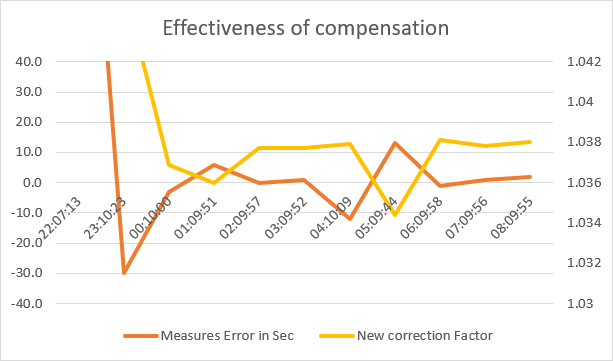
Rules to adapt DeepSleep period to battery level.~
In some applications, it is interesting to adjust the DeepSleep period to the level of the battery. For this, we consider that:
- the battery level is measured by the ESP ADC with the appropriate voltage divider,
- the Tasmota ADC mode is set to Range mode,
AdcParams 6has been used so the range value represent the battery voltage in millivolts- There is a
BatteryPercentagefeature that can be feeded by a rule and used here to drive DeepSleep behavior
The below graph represent the adaptation paths we want to follow to adjust DeepSleepTime: one path while the level is dropping, another path while the level is rising.

To implement this in Tasmota we can use Rules. As Rules do not provide an AND operator, we also need the optional IF feature. This requires to compile a customized firmware with the following items in user_config_override.h:
#define USE_RULES
#define SUPPORT_IF_STATEMENT
First, we need to know the current value of DeepSleepTime. Values for internal settings are not available as %variable% but they can generally be obtained by sending the command and capturing the result with a rule. To get the current value of DeepSleepTime, we need a trigger early in the boot process. For example Wifi#Connected.
Our first rules to get the current DeepSleepTime into %var1% would be:
ON Wifi#Connected DO Backlog DeepSleepTime ENDON
ON DeepSleepTime#Data DO var1 %value% ENDON
The best moment to compare the battery level and decide if it is necessary to change the DeepSleepTime is right after the TelePeriod SENSOR message has been sent, which is just before Tasmota calculate the next wake-up time. So we can use tele-ANALOG#Range as a trigger for our rules. Using BREAK allows to compare the trigger only to the upper value of the segment and stop further rules evaluations if the comparison is met. In the rule statement for a given battery level, we compare the current value of DeepSleepTime (which is %var1%) with the value we vant (given by the graph). If the current value is lower than the value we want, we are on the decreasing path and we can apply the new value. If the current value is greater than the value we want, we are on the rising path and we can apply the new value.
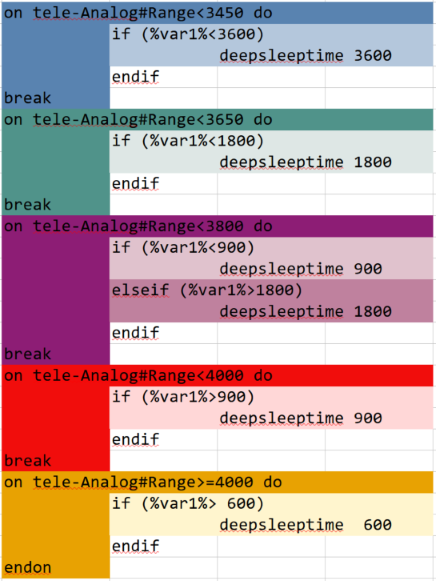
All above can be set into Rule1. As it is a long command, it may be necessary to enter the rule in 2 parts (note the usage of the +) :
Rule1 on Wifi#Connected do backlog deepsleeptime endon on deepsleeptime#data do var1 %value% endon on tele-Analog#Range<3450 do if (%var1%<3600) deepsleeptime 3600 endif break on tele-Analog#Range<3650 do if (%var1%<1800) deepsleeptime 1800 endif break
Rule1 +on tele-Analog#Range<3800 do if (%var1%<900) deepsleeptime 900 elseif (%var1%>1800) deepsleeptime 1800 endif break on tele-Analog#Range<4000 do if (%var1%>900)deepsleeptime 900 endif break on tele-Analog#Range>=4000 do if (%var1%> 600) deepsleeptime 600 endif endon
Don't forget to enable using Rule1 1
DeepSleep Power Saving~
The amount of power saved during deep sleep depends significantly on the type of ESP module used. For example, an ESP-M3 module drops to 20-25 uA at 2.5-3.3 V when in deep sleep. Other devices, with onboard regulators, USB chips etc. like the WEMOS D1 Mini, may still require 18 mA at 5 V when in deep sleep (i.e.: greater than 1000 times more power).